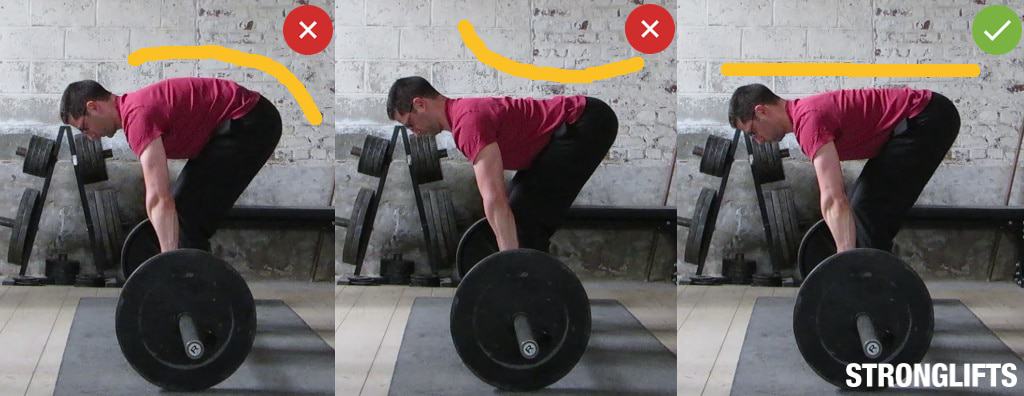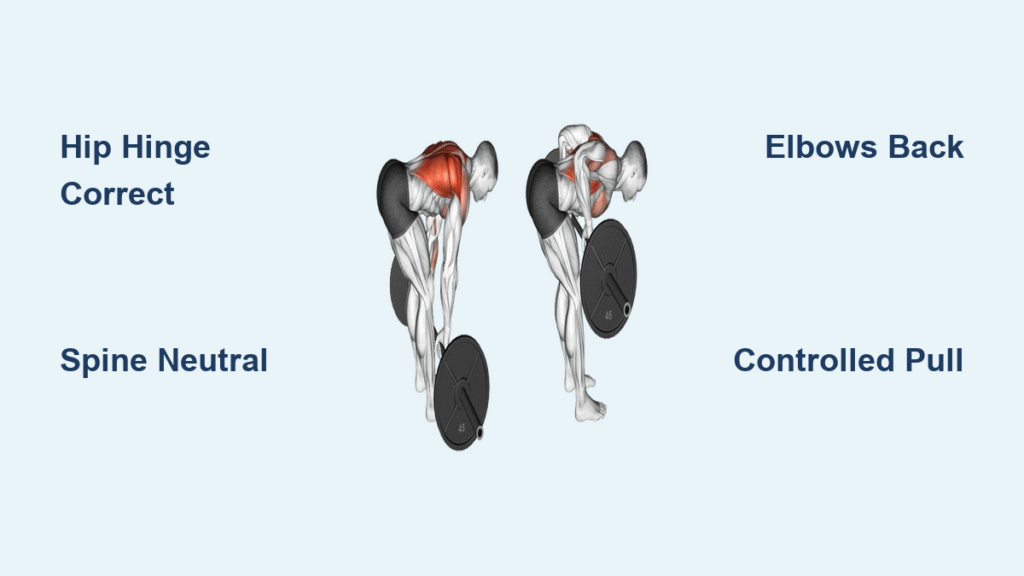Ever watch someone at the gym violently jerking a barbell upward while their back resembles a question mark? That’s exactly what barbell bent over row form should never resemble. This fundamental back exercise can build serious thickness across your lats and upper back—but only when performed with meticulous attention to detail. The difference between developing that coveted V-taper and spending weeks nursing lower back pain often comes down to a few critical positioning errors that 85% of lifters make without realizing it.
Whether you’re struggling to feel your back working during rows or dealing with nagging discomfort after your workout, fixing your technique will transform your results. You’ll learn the exact body positioning that separates effective rowing from dangerous momentum-based movements, plus the subtle cues that ensure every rep builds strength rather than setting you up for injury. Most lifters miss the critical relationship between hip hinge mechanics and back engagement—this guide will fix that oversight permanently.
Achieve the Correct Starting Position
Proper Grip and Initial Setup
Stand with your feet shoulder-width apart and approach the barbell positioned on the floor. Bend at your hips (not your waist) to grasp the bar with a pronated grip—palms facing down—just outside your knees. Your wrists, elbows, and shoulders must align in a straight line to create optimal force transfer through your body.
Critical setup points before lifting:
– Maintain a slight bend in your knees (15-20 degrees)
– Keep your spine in neutral alignment—neither rounded nor excessively arched
– Position shoulders directly over the bar
– Engage your core as if bracing for impact
Safe Bar Removal Technique
Lift the bar from the floor by driving through your heels and maintaining your hip hinge position—not by straightening your back. Many lifters make the critical mistake of standing upright with the bar before beginning their rows, which completely defeats the purpose of the exercise. The bar should travel in a straight vertical line from floor to starting position without your torso changing angle.
Master the Hip Hinge Mechanics

Optimal Torso Angle for Back Engagement
Your torso should remain at approximately 45 degrees from the floor throughout the movement—not parallel to the ground as some coaches incorrectly suggest. This specific angle creates the perfect tension across your entire back musculature while protecting your spine. Think of pushing your hips back as if closing a car door with your glutes while keeping your knees slightly bent for stability.
Visual cue to check your position: Have a training partner stand beside you—if they can see both your face and your feet without moving their head, your angle is perfect.
Maintain Spinal Integrity Under Load
Lock your spine into neutral alignment by engaging your entire core musculature. This isn’t just about avoiding lower back rounding—it’s about creating a rigid pillar that transfers force efficiently from your lower body through your back muscles. Your head position should follow your spine naturally; looking up or tucking your chin excessively disrupts this critical alignment.
Execute the Row with Precision
The Perfect Pulling Motion
Initiate each rep by driving your elbows back and up toward the ceiling—not by curling the bar with your hands. Your hands should function as hooks while your elbows create the movement path. Pull the bar in a straight line toward your lower abdomen, making contact precisely at belly button level. This specific contact point ensures maximum latissimus dorsi engagement while minimizing upper trap involvement.
Common mistake correction: Many lifters pull the bar toward their chest, which shifts emphasis to the rear deltoids and reduces lat activation. The belly button target point creates superior muscle recruitment patterns.
Controlled Eccentric Phase for Maximum Growth
Lower the barbell slowly over 2-3 seconds until your elbows reach full extension. This deliberate descent creates greater muscle damage (in a good way) and builds strength throughout the entire range of motion. Never allow the bar to crash to the bottom position or relax your back tension between reps—maintain constant engagement for optimal results.
Fix These Common Form Breakdowns

Rounded Back Correction Protocol
If your spine loses neutral alignment during the pull, immediately reduce the weight. A rounded back under load dramatically increases disc pressure and injury risk. This breakdown typically occurs either at the bottom of the movement or when lifters try to pull the bar too high. Focus on maintaining that rigid torso position first—strength will follow.
Quick fix: Practice bodyweight bent-over positions holding a PVC pipe along your spine. The pipe should maintain three points of contact (head, upper back, sacrum) throughout the movement.
Eliminate Momentum Cheating
Using body English to move heavier weight sabotages back development and transfers stress to your lower back. If your torso rises more than 10-15 degrees during the pull, the weight is too heavy. Drop the load by 20-30% and focus on strict form—your back will grow faster with lighter weights performed correctly than with heavy weights done poorly.
Advanced Technique Refinements

Targeted Muscle Emphasis Through Elbow Position
Slight adjustments to your elbow path can dramatically change which back muscles receive the most stimulation. For lower lat emphasis, keep elbows tucked at 45 degrees relative to your torso. For upper back development, allow elbows to flare out to 60-75 degrees. Most lifters benefit from a middle ground of 50-60 degrees for balanced development across the entire back.
Pro tip: Place your free hand on the target muscle group before starting your set—this simple tactile cue enhances mind-muscle connection by 30% according to electromyography studies.
Strategic Pausing for Strength Gains
Incorporate a one-second pause at the top position with the bar touching your torso and shoulder blades fully retracted. This eliminates momentum and maximizes time under tension where the muscle is most contracted. The pause should feel like you’re trying to squeeze a pencil between your shoulder blades.
Programming for Optimal Back Development
Weight Selection Based on Form Thresholds
Choose a weight that allows you to maintain perfect form for your target rep range. A useful benchmark: if you can’t perform at least 8 reps with strict technique while maintaining your hip hinge position, the weight is too heavy. Most lifters should start with 50-60% of their deadlift working weight for bent-over rows.
Progression protocol: Only increase weight when you can complete all reps of your final set with perfect form. A 2.5-5lb increase is sufficient for continued progress without form breakdown.
Rep Range Strategies by Training Goal
- Strength development: 4-6 reps with 2-3 minute rest periods
- Muscle hypertrophy: 8-12 reps with 60-90 second rest periods
- Muscular endurance: 15+ reps with 45-60 second rest periods
Troubleshooting Common Discomfort
Lower Back Pain Solutions
Discomfort in your lumbar region during rows almost always indicates compromised spinal alignment. Immediately reduce the weight and focus on maintaining neutral spine throughout the movement. Strengthen your posterior chain with glute bridges and bird-dog exercises to support proper rowing mechanics. Consider substituting chest-supported rows temporarily while you rebuild your hip hinge pattern.
Wrist and Elbow Strain Prevention
Wrist pain typically stems from improper alignment between wrists, elbows, and shoulders. Ensure your grip creates a straight line from wrist through elbow to shoulder—no excessive bending at the wrist joint. For elbow discomfort, check that you’re not flaring elbows excessively or pulling with improper mechanics. Using a slightly wider grip often alleviates elbow strain.
Expert-Level Performance Tips
Breathing technique: Inhale deeply as you lower the bar, then exhale forcefully as you pull upward. This breathing pattern creates essential intra-abdominal pressure that stabilizes your spine under load.
Grip strategy: For higher rep sets (12+), consider using lifting straps to prevent grip fatigue from limiting your back development. Reserve your raw grip for lower rep strength work and deadlift variations.
Mind-muscle connection boost: Before your working sets, perform 10-15 bodyweight scapular retractions (pulling shoulders back without moving arms) to activate your lats. This simple priming technique significantly enhances muscle recruitment during your actual rows.
Mastering barbell bent over row form transforms this basic movement into one of the most effective back builders in existence. Focus first on perfecting your hip hinge mechanics, then refine your pulling path and tempo. Start with lighter weights than you think you need—strict form with moderate weight will build more back muscle than sloppy technique with heavy weights every single time. Within just 4-6 weeks of precise execution, you’ll notice improved posture, greater strength carryover to other lifts, and that distinctive back thickness that turns heads at the gym. Your future self (and your spine) will thank you for taking the time to learn proper barbell bent over row form correctly.




